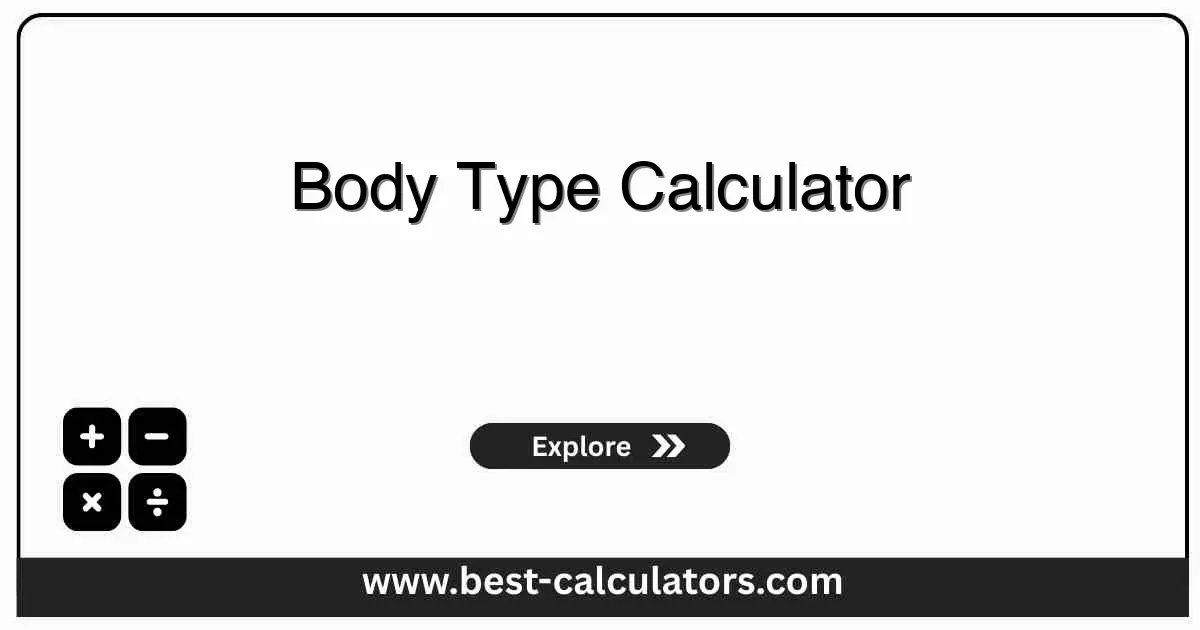Body Type Calculator - Determine Your Somatotype
Free body type calculator to identify your somatotype and get personalized fitness and nutrition recommendations
Body Type Calculator
Results
What is a Body Type Calculator?
A Body Type Calculator is a free fitness tool that determines your somatotype (ectomorph, mesomorph, or endomorph) based on skeletal measurements and body proportions. It provides personalized fitness and nutrition recommendations tailored to your genetic body structure for optimal results in muscle building, fat loss, and overall health.
This calculator works for:
- Fitness planning - Customize workouts for your body type
- Nutrition optimization - Adjust macros based on somatotype
- Weight management - Understand natural tendencies
- Training efficiency - Maximize results with targeted approach
To calculate body composition, check out our Body Fat Percentage Calculator to determine fat mass and lean body mass for fitness tracking.
For ideal weight targets, explore our Ideal Body Weight Calculator to find healthy weight range based on height and frame size.
To plan nutrition, use our Macronutrient Calculator to determine optimal protein, carbs, and fats for your body type and goals.
For muscle building, try our Protein Calculator to calculate daily protein needs based on body type and training intensity.
How Body Type Calculator Works
The calculation uses skeletal measurements:
Classification criteria:
- Ectomorph = Small wrist (<6.5" F, <7" M), narrow shoulders
- Mesomorph = Medium wrist (6.5-7.5" F, 7-8" M), broad shoulders
- Endomorph = Large wrist (>7.5" F, >8" M), wider waist
Shoulder-to-waist ratio indicates body shape. Mesomorphs have highest ratio (1.4+), ectomorphs moderate (1.2-1.4), endomorphs lower (<1.2). Wrist size indicates bone structure and frame size, which is genetic and unchangeable.
Key Concepts Explained
Ectomorph
Lean, long limbs, fast metabolism. Difficulty gaining weight. Needs high calories and heavy lifting for muscle growth.
Mesomorph
Athletic, muscular, medium frame. Gains muscle easily. Responds well to varied training and balanced nutrition.
Endomorph
Larger frame, gains weight easily. Slower metabolism. Benefits from lower carbs and higher cardio for fat loss.
Somatotype
Genetic body classification system. Most people are combinations. Determines optimal training and nutrition approach.
How to Use This Calculator
Measure Wrist
Measure wrist circumference at narrowest point below hand. Use measuring tape in inches.
Measure Shoulders
Measure shoulder width from bone to bone across back. Stand naturally, don't flex.
Measure Waist
Measure waist at narrowest point, typically above belly button. Don't suck in stomach.
Get Results
View body type classification and personalized fitness and nutrition recommendations.
Benefits of Using This Calculator
- •Personalized Training: Customize workouts based on genetic body type for maximum muscle growth and fat loss results.
- •Optimized Nutrition: Adjust macronutrient ratios to match metabolism and body composition tendencies.
- •Realistic Expectations: Understand natural body tendencies to set achievable fitness goals and avoid frustration.
- •Efficient Progress: Work with your genetics rather than against them for faster, sustainable results.
- •Targeted Approach: Focus efforts on strategies that work best for your specific somatotype.
- •Free Assessment: Determine body type instantly without expensive fitness assessments or consultations.
Factors That Affect Your Results
1. Genetic Factors
Bone structure and frame size are inherited. Somatotype is determined by genetics and cannot be changed through diet or exercise.
2. Body Composition
While skeletal structure is fixed, muscle mass and body fat can change. Most people are combinations of types.
3. Measurement Accuracy
Precise measurements are crucial. Measure at correct anatomical points. Have someone assist for shoulder width measurement.
4. Age and Hormones
Metabolism and body composition change with age. Hormonal changes affect weight distribution but not underlying bone structure.
5. Training History
Years of training can build muscle and change appearance, but skeletal frame remains constant. Ectomorphs can look muscular with training.

Frequently Asked Questions (FAQ)
Q: What are the 3 body types?
A: The three somatotypes are ectomorph (lean, difficulty gaining weight), mesomorph (muscular, athletic build), and endomorph (larger frame, gains weight easily). Most people are a combination of types with one dominant characteristic.
Q: How do I know my body type?
A: Determine body type by measuring wrist circumference, shoulder-to-waist ratio, and assessing weight gain patterns. Ectomorphs have small wrists (<6.5 inches for women, <7 inches for men), mesomorphs have medium frames, endomorphs have larger frames.
Q: Can body type change?
A: Skeletal structure (somatotype) is genetic and unchangeable. However, body composition can change through diet and exercise. Ectomorphs can build muscle, endomorphs can lose fat, but underlying bone structure remains constant.
Q: What is the best diet for my body type?
A: Ectomorphs need higher carbs (50-60%) for energy, mesomorphs benefit from balanced macros (40% carbs, 30% protein, 30% fat), endomorphs do better with lower carbs (25-35%) and higher protein (35-40%) for fat loss.
Q: How should I train for my body type?
A: Ectomorphs need heavy compound lifts with minimal cardio. Mesomorphs respond well to varied training with moderate cardio. Endomorphs benefit from high-intensity interval training and circuit training with more cardio for fat loss.